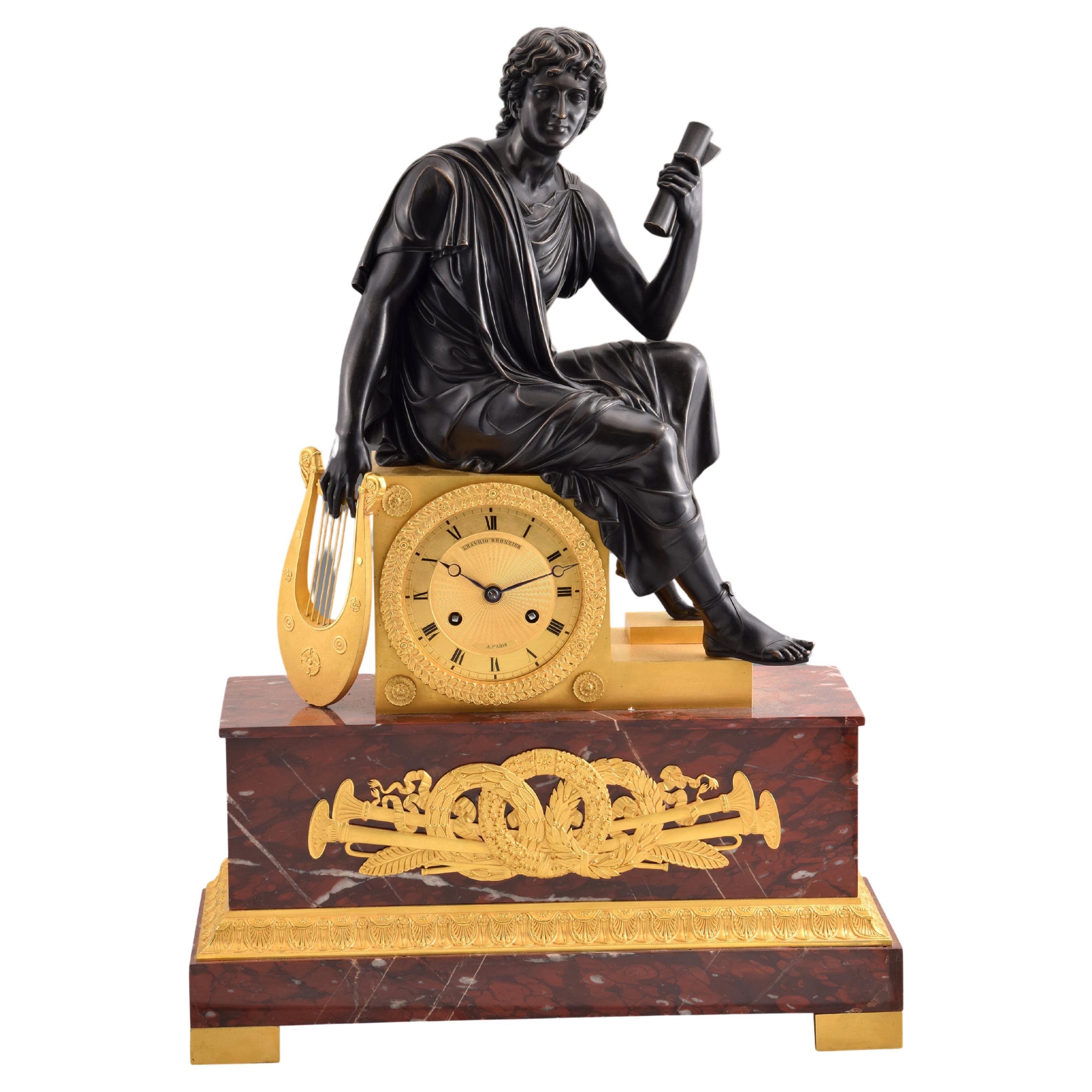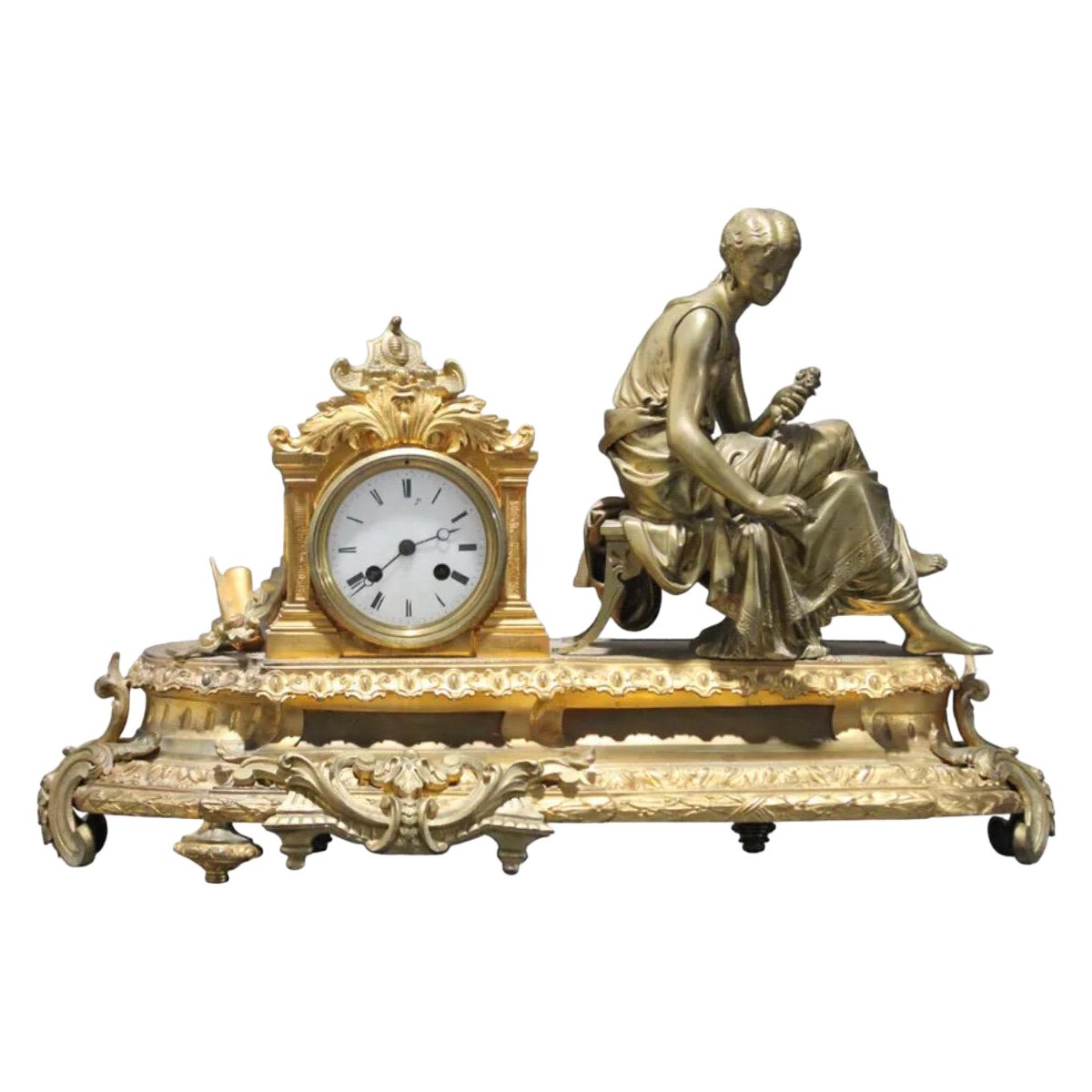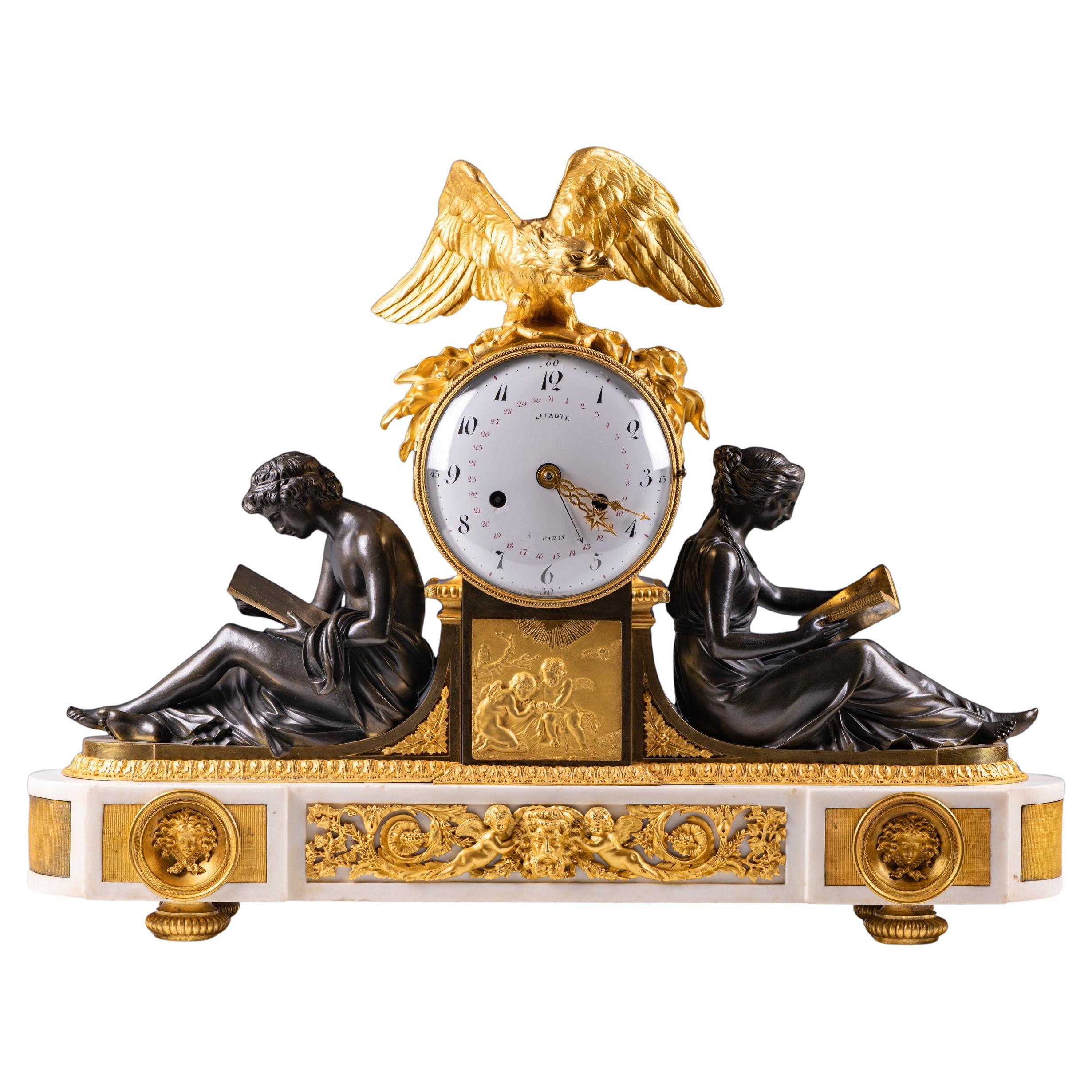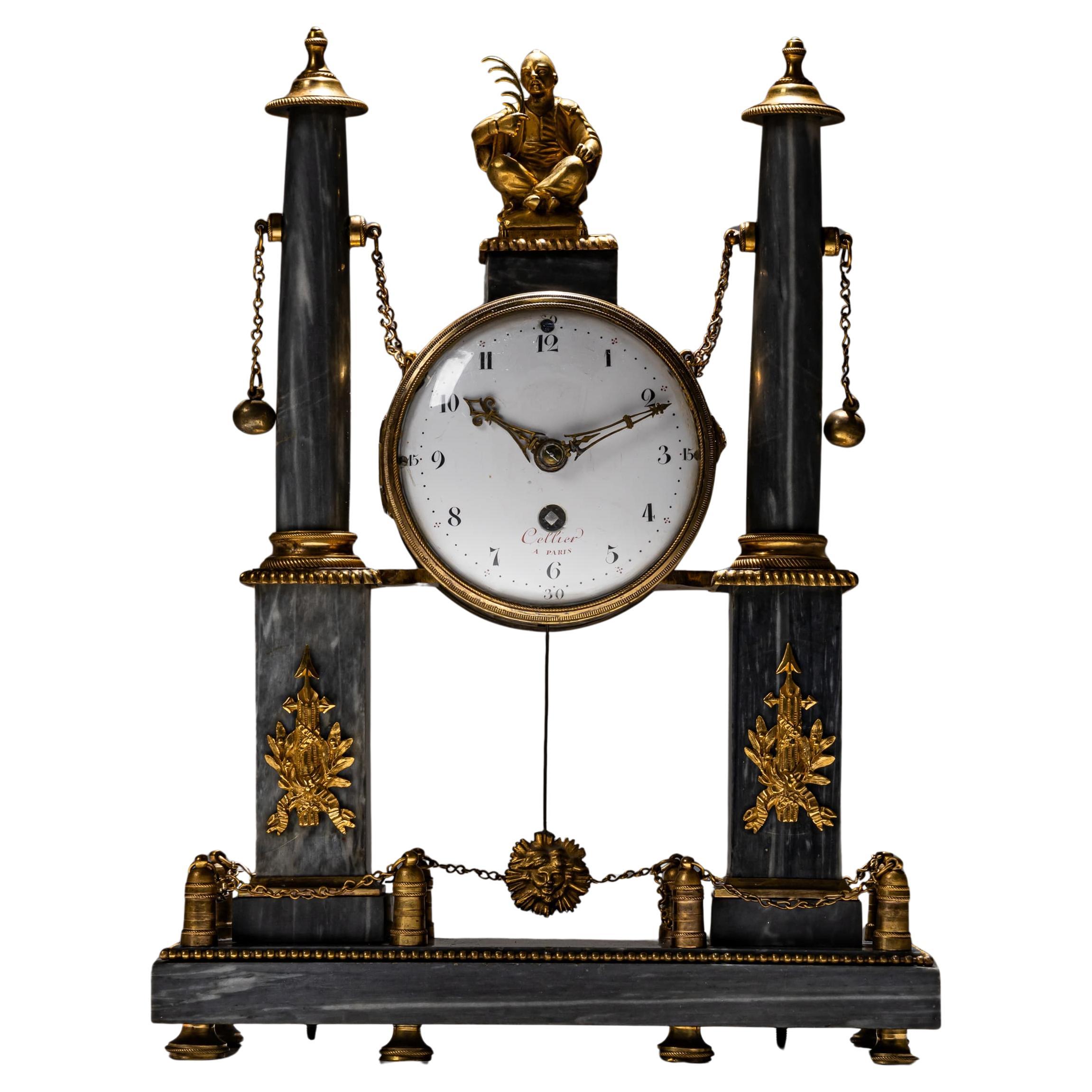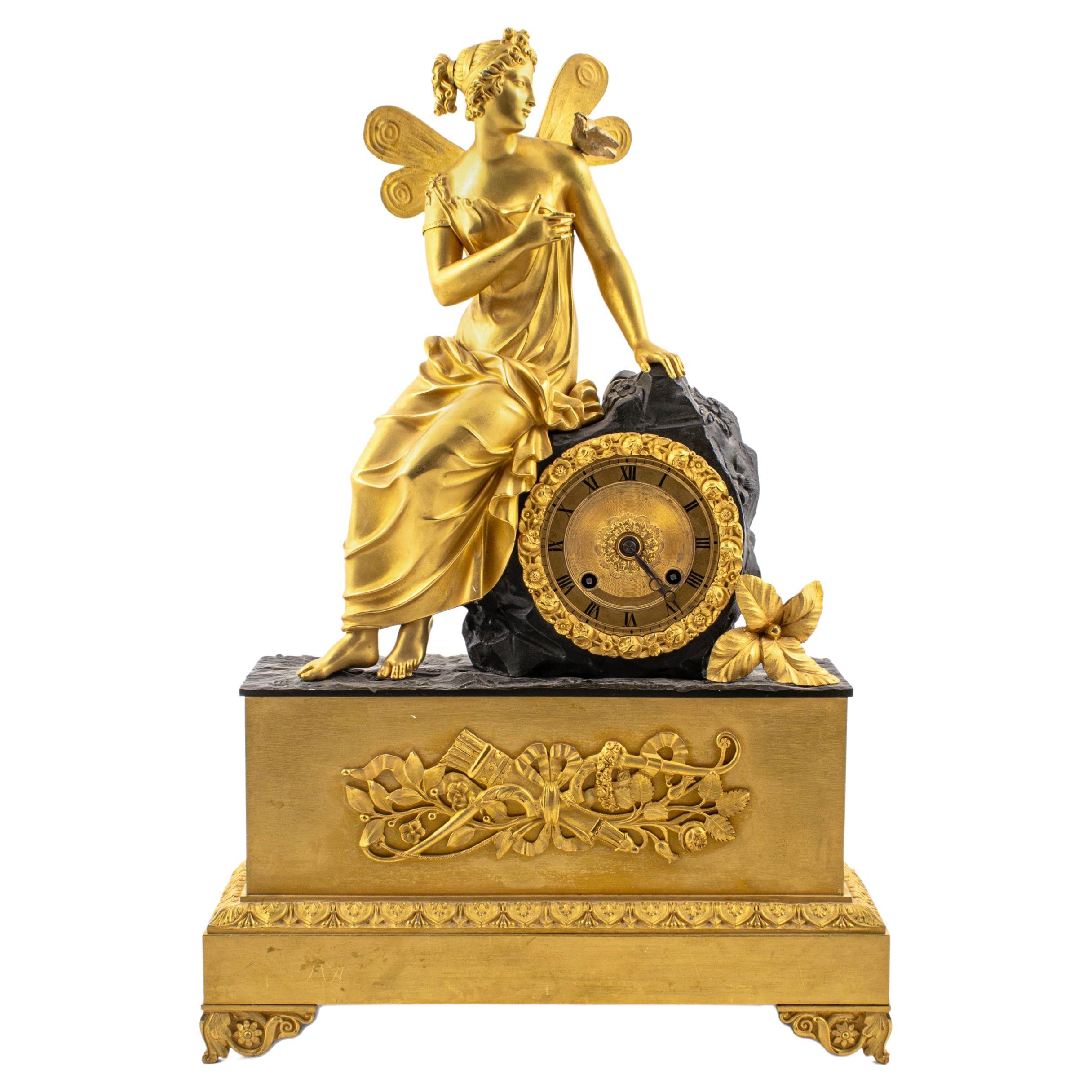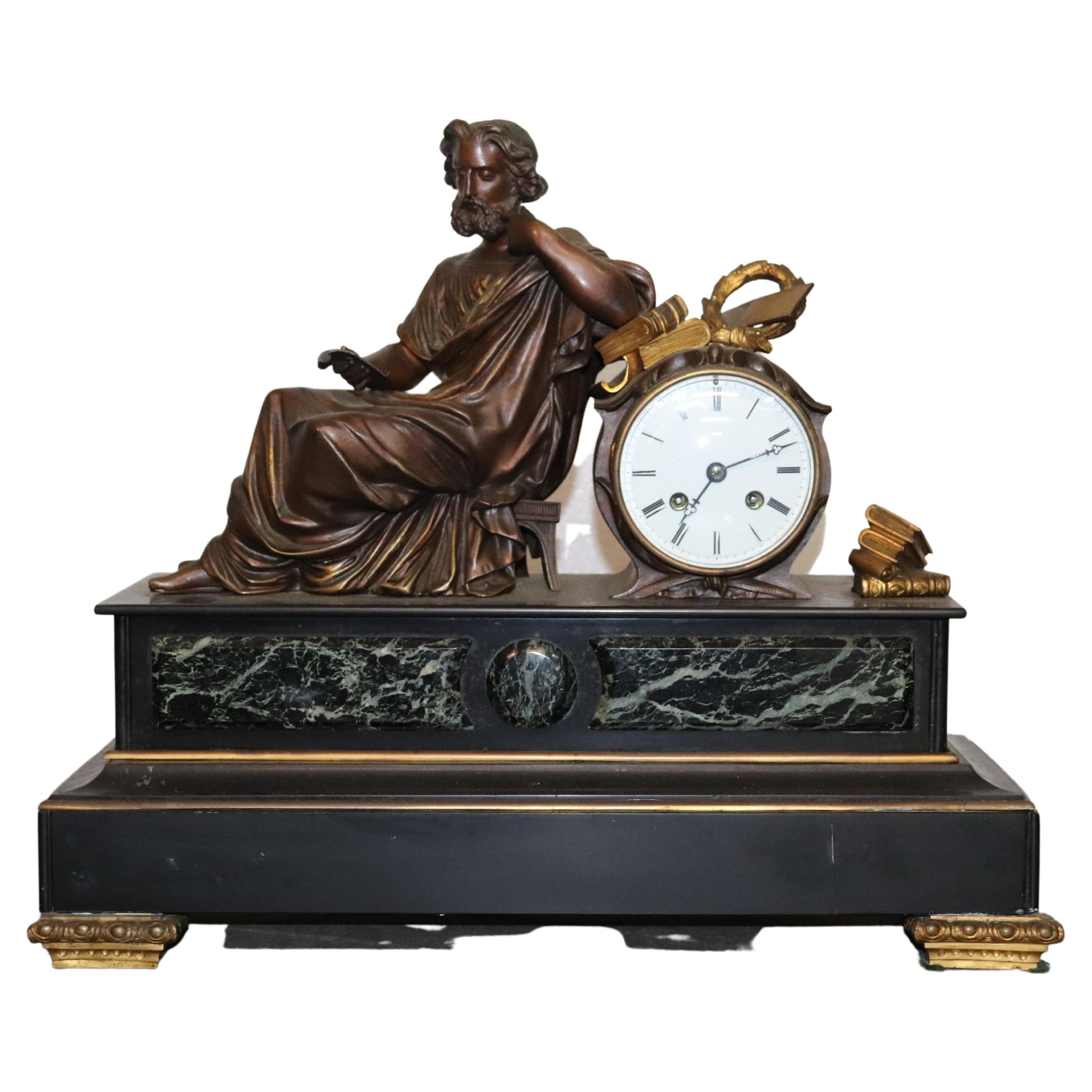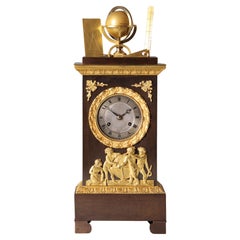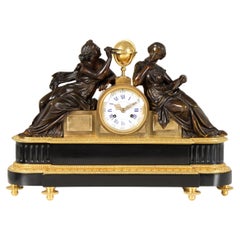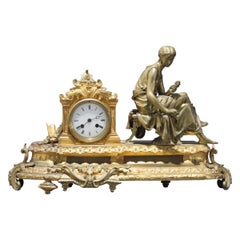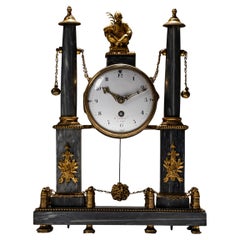Items Similar to 1830s French Table Clock, signed by LESIEUR á Paris, Pendule "Virgil the Poet"
Video Loading
Want more images or videos?
Request additional images or videos from the seller
1 of 22
1830s French Table Clock, signed by LESIEUR á Paris, Pendule "Virgil the Poet"
$8,018.94
£6,015.67
€6,750
CA$11,102.80
A$12,066.84
CHF 6,466.72
MX$146,512.88
NOK 81,185.80
SEK 75,287.49
DKK 51,422.47
About the Item
Pendule - Virgil the Poet
Paris
Bronze, marble
around 1830
Dimensions: H x W x D: 61 x 43 x 17 cm
Description:
Large and, at around 30 kg, very heavy French bronze clock from the Restoration Era around 1830.
The two-tiered base made of Siena marble is divided by a dark patinated palmette frieze. The upper part is adorned with laurel wreaths and Roman tubes.
Above this is the clockwork set into a stair-like pedestal. At the top sits the young Virgil with a papyrus scroll in his left hand and a lyre in his right. He wears Roman caligae on his feet and the light fabric of his tunic hints at his athletic physique.
The quality of the bronze work is first-class. The proportions are perfect and the drapery looks realistic. Details such as the feet and hands are excellently crafted.
The pyramidal structure of the clock and the calm sitting position of Virgil create a harmonious and harmonious overall composition. The dark patinated bronze contrasts beautifully with the light-coloured stone.
The gilt bronze dial is finely guilloché and has two signature plaques. Below the XII we see the signature of the bronzier Choiselat Gallien Fab(rican)t de Bronzes du G(ar)de Meuble.
The Choiselat-Gallien company was one of the leading Parisian bronze manufacturers at the beginning of the 19th century. It was founded by Louis-Isidore Choiselat, who was probably apprenticed to Jean-Baptiste Matthieu Gallien, whose business he later took over. Choiselat's customers included the Count of Artois, later King Charles X of France, for whose coronation he created the altarpieces.
Choiselat's workshop was located in the Rue de la Verrerie in Paris.
The clockmaker Lesieur H(orloger) à Paris signed above the VI and on the back plate of the movement.
The movement is a French pendulum movement with a thread suspension of the pendulum and lock disc striking mechanism with half-hourly striking.
According to Tardy, the Lesieur family of clockmakers can be traced back to 1806 in Paris. When this clock was made around 1830, the workshop was located in the Rue de la Verrerie, as was that of the bronzier.
When dismantling and cleaning the movement, I noticed an engraved date -1824- on the springs (see photo). As the springs were certainly not made by the clockmaker himself, but were bought in at the time, it can be assumed that the date comes from the spring maker.
Condition:
Beautiful and authentic condition with signs of age and wear. The movement has been dismantled and overhauled. It runs absolutely reliably and accurately.
You will find a comparable clock in the reference book:
Patrimonio Nacional Madrid - Catalogo de Relojes p. 247
The clockmaker is listed in the following directory:
Tardy - Dictionaire des Horlogers Francais p. 411
- Creator:Lesieur (Clockmaker)
- Dimensions:Height: 24.02 in (61 cm)Width: 16.93 in (43 cm)Depth: 6.7 in (17 cm)
- Style:Restauration (Of the Period)
- Materials and Techniques:
- Place of Origin:
- Period:
- Date of Manufacture:1835
- Condition:Wear consistent with age and use. Beautiful and authentic condition with signs of age and wear. The movement has been dismantled and overhauled. It runs absolutely reliably and accurately.
- Seller Location:Greven, DE
- Reference Number:1stDibs: LU5419240826232
About the Seller
5.0
Platinum Seller
Premium sellers with a 4.7+ rating and 24-hour response times
Established in 2014
1stDibs seller since 2020
212 sales on 1stDibs
Typical response time: 1 hour
- ShippingRetrieving quote...Shipping from: Münster, Germany
- Return Policy
More From This Seller
View All19th Century Mantel Clock "Astronomy", France circa 1830
Located in Greven, DE
Antique mantel clock on the theme of astronomy
France
Bronze
Charles X around 1830
Dimensions: H x W x D: 48 x 19 x 10 cm
Description:
Unusual and beautifully crafted bronze mante...
Category
Antique 19th Century French Charles X Table Clocks and Desk Clocks
Materials
Bronze
Early 19th Century French Mantel Clock, signed Ferey au Havre, Ormolu
Located in Greven, DE
Small mantel clock with bas-relief
France
Bronze, enamel
early 19th century
Dimensions: H x W x D: 33 x 19 x 9 cm
Description:
Antique, fire-gilt portal clock with figurative, Gre...
Category
Antique Early 19th Century French Empire Mantel Clocks
Materials
Bronze, Enamel, Ormolu
19th Century French Louis XVI Style "Astronomy" Mantel Clock, circa 1845
By Perrelet
Located in Greven, DE
French mantel clock "Astronomy"
Paris
Bronze, marble
Mid 19th century
Dimensions: H x W x D: 38 x 55 x 16 cm
Description:
A Louis XVI-style figural mantel clock mounted on a two-t...
Category
Antique 1840s French Louis XVI Mantel Clocks
Materials
Marble, Bronze
French Empire Ormulu Bronze Mantel Clock, Lepaute, Thomire, Paris, circa 1815
Located in Greven, DE
Ormulu pendule with depiction of friendship and love
Paris (Lepaute, Thomire)
fire-gilt bronze
Empire around 1815
Dimensions: H x W x D: 44 x 36 x 13 cm
French pendulum movement with eight days duration. Thread suspension and lock disc striking movement with strike on bell on the half and full hour.
White enamel dial with Roman hour numerals and Breguet hands.
Signature: LePaute & Fils / Hrl. du Roi (Pierre-Basile Lepaute (1750 - 1843) with his son Pierre-Michel Lepaute (1785-1849); from 1811 in joint workshop).
Description:
The extremely high quality pendulum shown here takes up a profound theme: Friendship, which combines with love and can thereby outlast time and death. As it is typical for the epoch of classicism, personifications and symbols are taken from the fund of ancient mythology and art and then developed further.
The main figure is a young woman in an antique, girded garment, standing barefoot and with crossed legs next to an altar, on which she is leaning with her left elbow. She gracefully bows her head towards a tempestuously approaching Cupid, grasps his right hand with her left and draws him to her bosom, the seat of the heart. The delicate ambivalence of flying towards and being held culminates in the trustingly intimate look that the two cast at each other.
The young woman personifies friendship, the winged Cupid love. As a sign of their intimate connection, two burning hearts appear on the altar next to the two, framed by the puffed scarf, which are closely bound together by a chain of flowers.
Next to them, on the altar slab, one can see an erected book with the title "Amitie" (French: amitie, friendship). Supporting the book is a pomegranate held by a ring of pomegranate flowers. The bursting seeds spill out of the cracked skin. Since ancient times, the pomegranate and its blossoms have been dedicated to the goddess Persephone, symbolizing the underworld and death, but also life and fertility. The myrtle interwoven in the pomegranate flower wreath of "friendship" also has a far-reaching symbolic power: the plant was dedicated to the goddess Aphrodite, stands for virginity, and was and is therefore obligatory in the bridal wreath...
Category
Antique Early 19th Century French Empire Mantel Clocks
Materials
Bronze, Enamel
Empire Mantel Clock - La Bibliotheque, Ormolu, France, Paris, circa 1820
By Le Roi
Located in Greven, DE
Mantel Clock - La Bibliotheque - In the study room
Paris
fire-gilt bronze, enamel
Empire around 1820
Dimensions: H x W x D: 38 x 28 x 19 cm
Description:
Scenery mounted on an oval...
Category
Antique Early 19th Century French Empire Mantel Clocks
Materials
Bronze
Early 19th Century Ormolu Mantel Clock, Atala freeing Chactas, Paris, circa 1810
Located in Greven, DE
Mantel Clock "Atala and Chactas"
Paris
Bronze (fire-gilt and patinated), enamel
Empire around 1810
Dimensions: H x W x D: 40 x 32 x 11 cm
Description:
Very rare and extremely high quality French mantel clock, so-called Pendule Au Bon Sauvage.
Depicted are scenes from the love story "Atala or the love of two savages in the desert" written by Francois René Vicomte de Chateaubriand in 1801. At the beginning of the 19th century, this was probably the most famous love story in Europe, but today it has been forgotten.
The story, set in present-day Louisiana (USA), is roughly rewritten about the forbidden love between Chactas, a young Indian, and Atala, the beautiful daughter of a Spaniard.
Chactas is captured in a battle between two Indian tribes, chained to a palm tree and is to be sacrificed. Atala wants to save his life and convert him to Christianity. She unties him from the palm tree at night and they flee together into the wilderness of North America. Their love for each other grows stronger and stronger and they have prospects for a future together.
The story takes a tragic turn when Atala, who must remain a virgin due to a vow made by her mother, can no longer withstand the conflict of her feelings and commits suicide.
The main group of characters thus shows Chacta's liberation through Atala. Atala is leaning against a pile of logs. The animal fur thrown over the logs and the weapons leaning against the stack on the right give the impression of a night camp.
The bronze is of rarely beautiful quality, finely chiselled and makes the scene appear very lively. The contrast of fire-gilded and patinated bronze adds tension to the composition.
In the base we see the Entombment as the end of the tragic love story. This bronze work is also very detailed, the interplay of bright and matt gilding makes the flat relief appear much deeper than it is.
The depiction of the mantel clock presented here shows that the exotic was only known from stories and that the bronzier had his own ideas about the appearance of this distant world. The Indian, for example, has very European facial features and his skin was not black in reality, of course. The palm tree was also certainly not found in the North American wilderness.
The heart of the clock is a French pendulum movement, integrated into the wooden pile, with an eight-day power reserve and a lock plate striking a bell on the half and full hour. The pendulum is suspended on a thread, typical of the period. The classically shaped hands, so-called Breguet hands, are also typical of the time.
The enamelled dial has black Roman hour numerals, Arabic quarter hours and bears the signature: Le Roy hr. de Madame A PARIS.
Interesting facts:
The period from 1795 to about 1815 saw the creation of probably the most spectacular group of bronzes: The "Au bon Sauvage" pendulums - depictions of the "Noble Savage".
Today's viewers react to these objects with both fascination and irritation. Enthusiastic on the one hand about the obvious quality of the detailed bronzes and the allure of the exotic, on the other hand distanced and cautious because of the possible discrimination that is suspected behind them. The ambivalence of this feeling motivates the search for the conditions of origin of these pendulums.
Europeans found their new ideal of the natural man primarily in fictional and realistic travelogues about the Indians of North America...
Category
Antique Early 19th Century French Empire Mantel Clocks
Materials
Ormolu
You May Also Like
Table Clock, Apollo, Bronze, Marble, Model of Lenoir-Ravrio, Louis-Stanislas
Located in Madrid, ES
Table clock, Apollo. Bronze, marble. Model of Lenoir-Ravrio, Louis-Stanislas(1783-1846). Paris, around 1820.
Table clock composed of a staggered rectangular base made of red veined...
Category
Antique Early 19th Century French Neoclassical Mantel Clocks
Materials
Bronze, Other
Exceptional Antique French Bronze Clock 1860-1890s
Located in Media, PA
Exceptional antique french clock with superb bronze workmanship. Created by hand in the late 19th century, with utmost craftsmanship. The way the bronze figure is made is unreal, if ...
Category
Antique Late 19th Century French French Provincial Mantel Clocks
Materials
Bronze
Late 18th/19th Century French Empire Mantle Clock By Parisian Clockmaker Lepaute
By Lepaute
Located in Dublin, IE
A Fine & Most Impressive French Gilt, Patinated Bronze and White Marble Mantel Clock by Lepaute of Paris, France. Of impressive scale and refined Neoclassical design, the circular white enamel dial signed Lepaute à Paris within a gilt-bronze bezel surmounted by a finely cast and chased gilt bronze eagle with outspread wings perched on a laurel wreath. The clock flanked by two seated classical figures in dark patinated bronze, each reading from an open book, symbolising Knowledge and Wisdom. The central plinth panel finely cast with cherubs in relief, set upon a rectangular white marble base mounted with ormolu friezes of scrolling foliage and masks, raised on toupie feet.
The Lepaute family were among the most renowned horologists of the late 18th and early 19th centuries, supplying timepieces to the French royal court and many important clients of the Empire period. The fine casting and crisp chasing of this example, combined with its balanced architectural design, exemplify the high quality of Parisian clockmaking of the period.
Circa 1800-1810
France
Condition: Excellent overall condition with minor wear to gilding consistent with age. Movement complete and of fine quality. Fully serviced and in working order.
Key present.
Biography:
Jean André Lepaute...
Category
Antique Early 1800s French Neoclassical Mantel Clocks
Materials
Marble, Bronze, Ormolu
French Portico Clock Signed Cellier à Paris, 19th Century
Located in Greding, DE
Small portico clock made of gray marble with gilded applications. The cylindrical movement is enclosed between two columns, above which a figural top piece in the form of a seated Ch...
Category
Antique 19th Century French Empire Table Clocks and Desk Clocks
Materials
Marble, Bronze, Enamel
Louis Phillippe Bronze Clock, France, c 1830-1840
Located in Kastrup, DK
Louis Phillippe gilded and dark patinated bronze clock.
Young woman adorned with wings and a bird on the shoulder sitting on rock block.
Gilt dial with wreath of flowers.
Included ke...
Category
Antique Mid-19th Century French Louis Philippe Mantel Clocks
Materials
Bronze
Fine French Verdi Marble and Bronze Mantel Clock of an Enrobed Wise Old Scholar
Located in Swedesboro, NJ
This fine French Verdi marble and bronze mantel clock, circa late 19th century, is a remarkable example of neoclassical artistry and precision timekeeping. The piece features a beaut...
Category
Vintage 1920s French Neoclassical Revival Mantel Clocks
Materials
Marble, Slate, Bronze
$1,960 Sale Price
20% Off
More Ways To Browse
French Antique Tables
Used Furniture Paris
French Desk Paris
French Pendule
Pendule France
Poets Desk
18th Century English Bracket Clock
Strut Clock
Art Deco Mirrored Clock
Deco Mirror Clock
Silver English Clock
World Desk Clocks
George Iii Bracket Clock
Gubelin Clock
Hermes Clock
Rotating Clock
Small Desk Clock
Cartier Alarm Clocks
